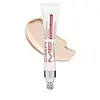What's inside
What's inside
 Key Ingredients
Key Ingredients

 Benefits
Benefits

 Concerns
Concerns

No concerns
 Ingredients Side-by-side
Ingredients Side-by-side

Water
Skin ConditioningGlycerin
HumectantPropanediol
SolventXanthan Gum
EmulsifyingArctostaphylos Uva Ursi Leaf Extract
Skin ConditioningLupinus Albus Seed Extract
Skin ConditioningHesperidin Methyl Chalcone
AntioxidantBiotin
AntiseborrhoeicChrysin
Skin ConditioningDipeptide-2
Skin ConditioningPalmitoyl Tetrapeptide-7
Skin ConditioningPalmitoyl Tripeptide-1
Skin ConditioningButylene Glycol
HumectantSodium Benzoate
MaskingPolyglyceryl-4 Caprate
EmulsifyingSteareth-20
CleansingPotassium Sorbate
PreservativeCitric Acid
BufferingSodium Citrate
BufferingChlorhexidine Digluconate
AntimicrobialSorbic Acid
PreservativeN-Hydroxysuccinimide
Skin ConditioningSodium Hydroxide
BufferingWater, Glycerin, Propanediol, Xanthan Gum, Arctostaphylos Uva Ursi Leaf Extract, Lupinus Albus Seed Extract, Hesperidin Methyl Chalcone, Biotin, Chrysin, Dipeptide-2, Palmitoyl Tetrapeptide-7, Palmitoyl Tripeptide-1, Butylene Glycol, Sodium Benzoate, Polyglyceryl-4 Caprate, Steareth-20, Potassium Sorbate, Citric Acid, Sodium Citrate, Chlorhexidine Digluconate, Sorbic Acid, N-Hydroxysuccinimide, Sodium Hydroxide
Water
Skin ConditioningC12-15 Alkyl Benzoate
AntimicrobialHydrogenated Polyisobutene
EmollientGlycerin
HumectantAcrylates Copolymer
Pvp
Emulsion StabilisingSilica
AbrasiveCetyl Alcohol
EmollientGlyceryl Stearate
EmollientPEG-100 Stearate
PEG-40 Stearate
EmulsifyingDimethicone
EmollientHydrolyzed Sesame Protein Pg-Propyl Methylsilanediol
Skin ConditioningHydrolyzed Wheat Protein
Skin ConditioningSoy Protein Phthalate
EmollientPolyacrylamide
C13-14 Isoparaffin
EmollientLaureth-7
EmulsifyingSteareth-20
CleansingN-Hydroxysuccinimide
Skin ConditioningChrysin
Skin ConditioningPalmitoyl Tripeptide-1
Skin ConditioningPalmitoyl Tetrapeptide-7
Skin ConditioningButylene Glycol
HumectantAcetyl Tetrapeptide-5
HumectantPhenoxyethanol
PreservativeEthylhexylglycerin
Skin ConditioningCI 77891
Cosmetic ColorantCI 77491
Cosmetic ColorantWater, C12-15 Alkyl Benzoate, Hydrogenated Polyisobutene, Glycerin, Acrylates Copolymer, Pvp, Silica, Cetyl Alcohol, Glyceryl Stearate, PEG-100 Stearate, PEG-40 Stearate, Dimethicone, Hydrolyzed Sesame Protein Pg-Propyl Methylsilanediol, Hydrolyzed Wheat Protein, Soy Protein Phthalate, Polyacrylamide, C13-14 Isoparaffin, Laureth-7, Steareth-20, N-Hydroxysuccinimide, Chrysin, Palmitoyl Tripeptide-1, Palmitoyl Tetrapeptide-7, Butylene Glycol, Acetyl Tetrapeptide-5, Phenoxyethanol, Ethylhexylglycerin, CI 77891, CI 77491
Ingredients Explained
These ingredients are found in both products.
Ingredients higher up in an ingredient list are typically present in a larger amount.
Butylene Glycol (or BG) is used within cosmetic products for a few different reasons:
Overall, Butylene Glycol is a safe and well-rounded ingredient that works well with other ingredients.
Though this ingredient works well with most skin types, some people with sensitive skin may experience a reaction such as allergic rashes, closed comedones, or itchiness.
Learn more about Butylene GlycolWe don't have a description for Chrysin yet.
Glycerin is already naturally found in your skin. It helps moisturize and protect your skin.
A study from 2016 found glycerin to be more effective as a humectant than AHAs and hyaluronic acid.
As a humectant, it helps the skin stay hydrated by pulling moisture to your skin. The low molecular weight of glycerin allows it to pull moisture into the deeper layers of your skin.
Hydrated skin improves your skin barrier; Your skin barrier helps protect against irritants and bacteria.
Glycerin has also been found to have antimicrobial and antiviral properties. Due to these properties, glycerin is often used in wound and burn treatments.
In cosmetics, glycerin is usually derived from plants such as soybean or palm. However, it can also be sourced from animals, such as tallow or animal fat.
This ingredient is organic, colorless, odorless, and non-toxic.
Glycerin is the name for this ingredient in American English. British English uses Glycerol/Glycerine.
Learn more about GlycerinWe don't have a description for N-Hydroxysuccinimide yet.
Palmitoyl Tetrapeptide-7 (formerly Palmitoyl Tetrapeptide-3) is a lab-made peptide with anti-inflammatory and skin-repairing benefits. It's made up of four amino acids (glycine, glutamine, proline, and arginine) and palmitic acid (which helps it penetrate skin more effectively).
This ingredient helps reduce inflammation by limiting the production of interleukin-6 (IL-6), a chemical that triggers inflammatory responses, particularly after UV exposure.
Less inflammation = slower collagen breakdown and a longer-lasting, youthful appearance.
Palmitoyl Tetrapeptide-7 also stimulates collagen production and supports a healthier skin barrier.
Over time, this can improve skin firmness, hydration, and reduce the appearance of fine lines. It’s commonly paired with Palmitoyl Tripeptide-1 in the well-known Matrixyl 3000 complex for enhanced anti-aging effects.
This ingredient has been shown to be effective and safe in cosmetic use and you'll typically find it in small amounts (less than 0.01%).
Due to its palmitic acid base, it may not be safe for Malassezia folliculitis.
Read more about other common types of peptides here:
Learn more about Palmitoyl Tetrapeptide-7Palmitoyl Tripeptide-1 is also known as pal-GHK. It is made up of 3 amino acids and palmitic acid, a fatty acid that helps it absorb into skin more easily.
This peptide is as a signal peptide, meaning it tells the skin to produce more collagen. Collagen is the key protein that helps form the skin's structure and keep it plump, firm, and hydrated.
By boosting collagen production, this ingredient supports a stronger skin barrier and helps reduce the appearance of wrinkles.
You'll most likely see this ingredient paired with Palmitoyl Tetrapeptide-7 in the well-known Matrixyl 3000 complex. While results from in-house testing should be viewed cautiously, this peptide duo is among the most studied and widely used in modern skincare.
Due to its palmitic acid base, this ingredient may not be safe for Malassezia folliculitis.
Read more about other common types of peptides here:
Learn more about Palmitoyl Tripeptide-1Steareth-20 is a waxy compound used to emulsify ingredients. It is created from stearyl alcohol.
It possesses surfactant properties. This means it reduces surface tension and helps oils, dirt, and pollutants to be washed away.
The 20 stands for the number of ethylene oxide used to create this ingredient.
Learn more about Steareth-20Water. It's the most common cosmetic ingredient of all. You'll usually see it at the top of ingredient lists, meaning that it makes up the largest part of the product.
So why is it so popular? Water most often acts as a solvent - this means that it helps dissolve other ingredients into the formulation.
You'll also recognize water as that liquid we all need to stay alive. If you see this, drink a glass of water. Stay hydrated!
Learn more about Water